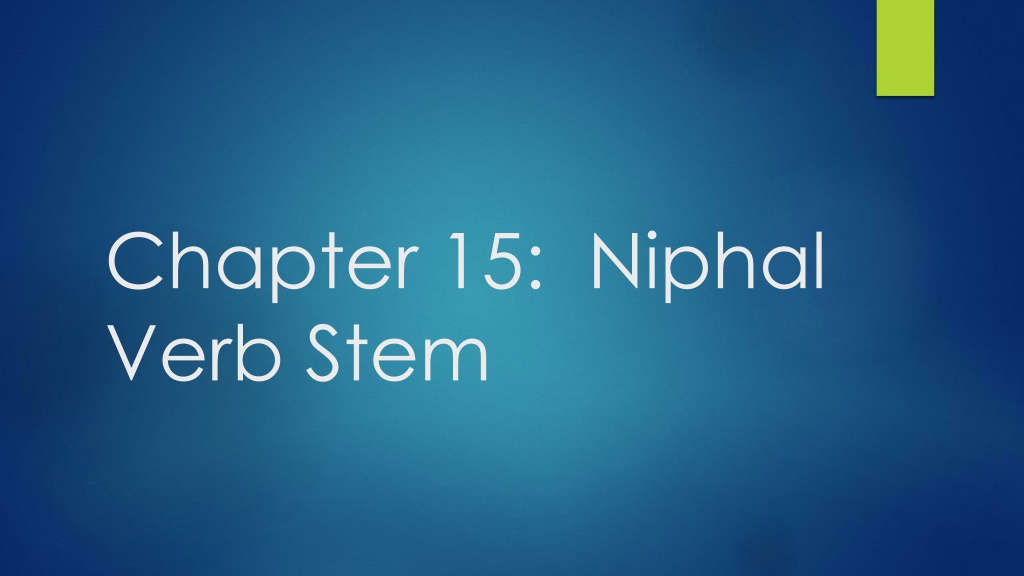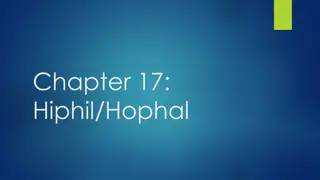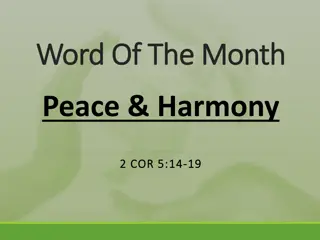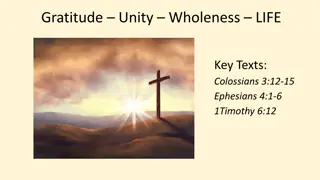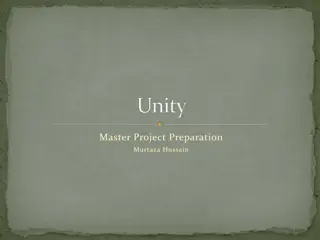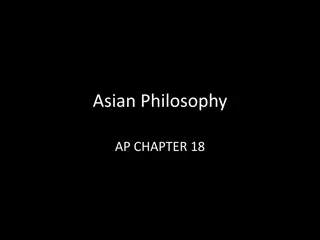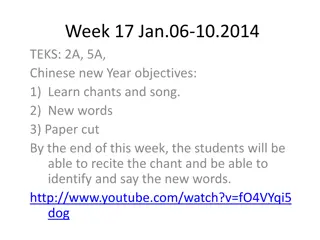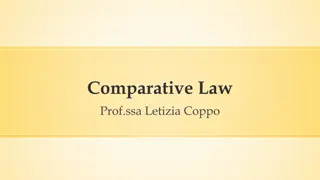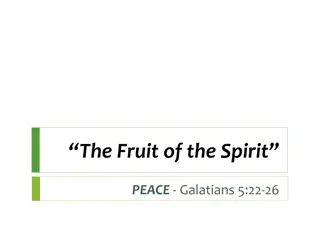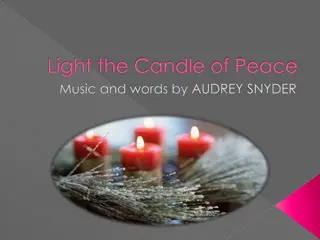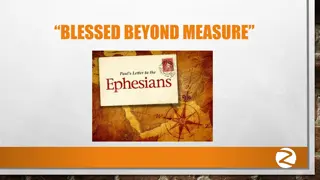Unity and Harmony Chants for Peace and Learning
Explore a collection of chants and songs promoting unity, harmony, and peace. The content includes Niphal Verb Stem, a Shema lullaby, Alphabet Song, Vanquishing the Vowel, Qal Perfect Chant, Noun Chant, and more. These chants emphasize the importance of togetherness and understanding in various linguistic and musical forms.
Download Presentation

Please find below an Image/Link to download the presentation.
The content on the website is provided AS IS for your information and personal use only. It may not be sold, licensed, or shared on other websites without obtaining consent from the author.If you encounter any issues during the download, it is possible that the publisher has removed the file from their server.
You are allowed to download the files provided on this website for personal or commercial use, subject to the condition that they are used lawfully. All files are the property of their respective owners.
The content on the website is provided AS IS for your information and personal use only. It may not be sold, licensed, or shared on other websites without obtaining consent from the author.
E N D
Presentation Transcript
Chapter 15: Niphal Verb Stem
as one brothers dwell How good and pleasant it is when brothers live together in unity! and how pleasant how good behold (repeat) Chorus: How good when brothers live together in unity! How good when brothers live together in unity!
4.L. Sing: Shema lullaby (Deut. 6:4) https://www.youtube.com/watch?v=pIOpZ9fQLbU&t=0s&list=PLnNXzYjQerJia_ 8yTy8OrM2K-BiN5OEup&index=2 or search Youtube for: Shema Lullaby Judy Ginsburgh Shabbat Shalom Medley https://www.youtube.com/watch?v=- MBgACM_LcE&list=RDEMSL0J_ngrs5U8EoQWZITH5w&index=9
5.I. Oseh Shalom He who makes peace in his high places may he let peace descent on us and on all Israel and say, say: Amen.
5.I. Oseh Shalom May he make peace, may he make peace Peace for us and for all Israel
Vanquishing the Vowel Long ( ) BAh -- Q me ( ) Bay er (Y d) Bee -- req Y d ( ) Bow lem (V v) Booh req (rule) Short bAh -- Pata ( ) Beh Segh l (Y d) Bi(t)-- req Bow-- Q me at f Booh-- Qibb Beh vocal ev Half Bah -- at f-pata Beh at f-Segh l Vowel Type A - type E - type I - Type O - Type Bow-- at f Q me U - Type - ( ) Bah-v silent ev
Qal Perfect Chant 1 CP we guarded 1CS I guarded 2 MP you (m.) guarded 2 MS you (m.) guarded 2 FS 2 FP you (f.) guarded you (f.) guarded 3 MS 3 CP they guarded he guarded 3 FS she guarded
Noun Chant Masculine Feminine Dual:
Chant Personal Pronouns 1stcommon I we 2ndmasc. you (m.) you /ye / you all (m.) 2ndfem. you (f.) you / ye / you all (f.) 3rdmasc. he / it they (m.) 3rdfem. she / it they (f.)
Chant: Preposition with Pronominal Suffixes 1 CS in me 1 CP in us 2 MS in you (m.) 2 MP in you (m.) 2 FS in you (f.) 2 FP in you (f.) 3 MS in him 3 MP in them (m.) 3 FS in her 3 FP in them (f.)
Demonstrative Pronouns: this and that This / these that / those who, which / /
Qal Imperfect Chant 1CS 1CP 2MP 3MP 2MS 2FS 2FP 3MS 3FS 3FP
9. F. Chant: Qal Perfect Weak Verb Ayin-Y d/V v L med-H to rise to build to give (3fs) 1CS 2MP 3CP
10.B. Chant: . P position--weak guttural Regular P -N n, P -Y d, P - lef P -Guttural 2MS/3FS
10.C. Chant II. Ayin position weak guttural: Regular Ayin-Y d/V v Ayin guttural Double Ayin 2MS/3FS
10.D. Chant: III. Lmed position: Regular L med-H L med-guttural L med- lef 2MS/3FS
11. D. Learn the following chant for : Imperative chant 2ms [you, m.s.] guard 2mp [you m.p.] guard 2fs [you, f.s.] guard [you f.p.] guard 2fp
12. A. Introduction to Infinitives Inf. Construct: (note it is the same as the 2ms Imperative) Inf. Absolute:
13. C. Participle chant: Qal Active Participle Singular Plural Masculine Feminine /
13. C. Participle chant: Qal Passive Participle Singular Plural Masculine Feminine
15 A. Introduction We have focused on the Qal stem as it dominates covering almost 70% of the verbs in the Tanak. We have learned the perfect, imperfect, imperative, infintives, and participle forms of the qal stem. We ve also examined the modifications that happen with the weak verbs. The next series of chapters will now begin to master the other binyanim or verb stems.
15 A. Introduction While the name of the Qal stem is built off of the word which means light or simple, the others will be built off the verb (to do, make). Hence they are called the Niphal ( ). It is sometimes written Nif al. Note that is the root to which the prefix is added and the vowels shifted from the simple Qal form .
Verbal system has seven constructions/ patterns Verbal system has seven constructions/patterns or binyanim [ ] The verbal system may be described as seven variations or stems built off the basic root ( = root) and pictured as:
The Seven binyanim []) 7 Verb Patterns (called binyanim [ ]) Simple Intensive Causative Active Qal ( ) Piel Hiphil ) ( ) ( Passive Niphal ( ) Pual ( ) Hithpael ( ) Hophal ( ) Reflexive
Seven verb patterns (the verb (to make) is used to identify the patterns Qal ( : simple/light, from it was light) P al he made 49,942x Niphal Nip al he was made (passive) 4161x Piel P l he made (intensive) 6491x Hiphil -- Hip l he caused to make (causative) 9386x
Seven verb patterns Hithpael Hitpa l he made himself (intensive reflexive) 842x Pual P al he was made (intensive passive) 417x Hophal -- Hophal ( ) -- he was caused to make (causative passive) 392x
15 B. The usage of the Niphal It is basically the passive of the Qal. An active verb is one where the subject does the action of the verb (e.g. Terry hit the ball). A passive verb is one where the subject receives the action of the verb (e.g. Terry was hit by the ball). Usually the passive form in English is achieved by inserting some form of the is verb, in the case above was shifts the hit to the passive where Terry receives the action of the verb even though he is the subject. So is he found and is he was found or is he hears and is he was heard.
15 B. The usage of the Niphal Quite often the passive in Hebrew will not express the agent (e.g. the ball) although in Hebrew the agent is often may be indicated by a prepositional or or Some verbs ( to hide; ) the Niphal can be used for a reflexive ( he hid himself ; he kept himself). Some verbs have no Qal in which case the Niphal form is used for the active meaning similar to if it had been a Qal ( he fought; he swore)
15 C. The morphology of the Niphal Perfect The Perfect of the Niphal for the regular verb is: just remember 3ms = 1CS 1CP we were guarded 2MP you (mp) I was guarded 2MS you (m) 2FS you (f) 2FP you (fp) he was guarded 3CP they were guarded 3MS 3FS she was guarded
15 C. The morphology of the Niphal Perfect The pronominal endings are added normally with the vocalic endings ( and ) causing the vowel under the second consonant to drop to a ev as they did in the Qal otherwise the simple ev is used to tack on the normal perfect suffixes ( , , , , , ). The on the front clearly will identify the form as a Niphal perfect verb.
Examples: and by a prophet he was guarded his faithful ones forever will be guarded (Hos 12:14) (Psa 37:28)
15. D. Weak Verb Perfect Niphals P Y d verbs: For the P Y d verbs one must remember that they originally were built from an initial v v where the y d now sits. Instead of the Niphal starting with a a will be tacked on the front. Other than that it is pretty straight forward. Here is the Niphal of (to sit, dwell) becomes .
P Yd verbs: 1CS 1CP we were seated 2MP you (mp) 2FP you (fp) 3CP they were seated I was seated 2MS you (ms) 2FS you (fs) 3MS he was seated 3FS she was seated
Example: I will make you a desert, they will be uninhabited cities (Jer 22:6)
P Nn Verbs: When you add the onto the front of a P N n verb the n n of the root assimilates into the second consonant of the verb doubling that second consonant with a doubling dagesh forte.
P Nn Verbs: 1CS I drew near 1CP we drew near 2MP you (mp) 2FP you (fp) 3CP they drew near 2MS you (ms) 2FS you (fs) 3MS he drew near 3FS she drew near
Example of for all of them will be given over to death unto the earth below (Eze 31:14)
P Guttural: The prefix shift to is the easy distinguishing mark of all of these. The ev under the initial guttural shifts to a at f-segh l ( ). When the vocalic sufformatives are added the at f- segh l under the guttural becomes a segh l.
P Guttural: 1CS I was stood 1CP we were stood 2MP you (mp) 2FP you (fp) 3CP they were stood 2MS you (ms) 2FS you (fs) 3MS he was stood 3FS she was stood
Lmed H Verbs: When you add the onto the front of a L med H verb it is normal. It is the final H where the action takes place. When the consonantal endings are added the H shifts to and totally drops out when the vocalic 3cp sufformative is added and a media is added for the 3fs.
Lmed H Verbs: 1CS 1CP we were built 2MP you (mp) 2FP you (fp) 3CP they were built I was built 2MS you (ms) 2FS you (fs) 3MS he was built 3FS she was built
lef H Verbs: 1CS 1CP we were found 2MP you (mp) I was found 2MS you (ms) 2FS you (fs) 2FP you (fp) 3CP 3MS he was found they were found 3FS she was found
15 D. The morphology of the Niphal Imperfect 1CS 1CP 2MP you (mp) 2FP you (fp) 3MP 3FP I will be kept we will be kept 2MS you (ms) 2FS you (fs) 3MS he will be kept they (m) will be kept 3FS she will be kept they (f) will be kept
15 D. The morphology of the Niphal Imperfect Note that the prefixes are added with a req except for the 1CS which utilizes a segh l. The n n assimilate causing the initial consonant to double as is expected. The vowel under the second consonant is usually a er dropping to a ev when a vocalic ending is added and a pata when the consonantal is added in the 2FP and 3FP.
Example: And all that I have said to you keep yourself (Exod 23:13)
15. P Yd verbs: 1CS 1CP 2MP I will be seated we will be seated 2MS you (ms) you (mp) 2FS you (fs) 2FP he will be seated 3MP you (fp) 3MS they (m) 3FS 3FP they (f) will be she will be seated seated
P Nn Verbs: 1CS 1CP we will draw near 2MP you (mp) 2FP you (fp) 3MP they (m) 3FP I will draw near 2MS you (ms) 2FS you (fs) 3MS he will draw near 3FS she will draw near they (f) will draw near
P Guttural: 1CS 1CP 2MP you (mp) I will be stood we will be stood 2MS you (ms) 2FS you (fs) 2FP you (fp) 3MS 3MP they (m) he will be stood 3FS she will be stood 3FP they (f) will be stood
Lmed H Verbs: 1CS 1CP we will be built 2MP you (mp) 2FP you (fp) 3MP they (mp) 3FP they (f) will I will be built 2MS you (ms) 2FS you (fs) 3MS he will be built 3FS she will be built be built
